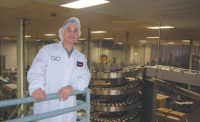Scott Sechler says that, at one point in time, the big corporations in the chicken industry would have considered him a player in the hobby business. Things have certainly changed within the last couple of decades. Sechler, owner of Bell & Evans, has led his company to become one of the premier chicken companies in the country, with premium prices, a loyal consumer following, and farmers lining up to grow chickens for the company. The biggest players are trying to convert their operations to the attributes that it has promoted for decades — antibiotic-free, organic, humanely raised and slaughtered.
“We’ve developed this market over many, many years,” he says. “I think we were one of the first or the first to have a natural chicken label, which I got about 33 years ago. Now, everything is labeled ‘natural.’”
Along with being one of the biggest proponents of air-chilled chicken in the country, Bell & Evans also boasts some of the newest facilities in the poultry industry. The company began operations in an organic certified and animal welfare-focused chicken hatchery in August 2017 and a packaging and further processing facility in 2015. Last month, the company announced plans to build a state-of-the-art chicken harvesting plant in its home of Fredericksburg, Pa. In making the announcement, Bell & Evans said it would be the first new build of a chicken harvesting facility in the northeast United States in over 40 years. The new plant is slated to begin operations in early 2020.
Sechler refers to the plant as a “European-plus” construction. The terminology refers to the approach that Europeans took to construction in the past, where buildings are built to last for generations, not just years.
“Everything, from our construction ideas to the equipment that we buy, is all around the long term,” he says, adding that he has a 50-year model when looking at new construction projects. “[European-plus is] a phrase tied to a high level of construction quality and building quality,” he says.
Along with the new harvest facility, Bell and Evans is also in the process of transitioning to a different breed of chicken, Das Klassenbester. The switch to the slower-growing breed is expected to be 100 percent complete by the end of 2018.
“The breed combinations we’re putting together, some would call them heritage-type birds,” Sechler explains. “What they are, really, is where we were about 15 years ago. Fifteen years ago, the scales were tipped, and the world started putting pressure on the geneticists to come up with chickens that grow faster, have better feed conversion and grow to higher weights.”
Sechler has been searching for a better breed of chicken for more than three years, working with European breeders. The domestic breeds are favored by the large producers because they grow larger quicker, but Sechler does not like the health problems that come about as a result: skeletal, cardiovascular and muscular issues in the live birds, and white striping and woody breasts in the meat. The Klassenbester breed was created by combining females from a breed known for its slow growth and high meat yield with males from a breed known for its excellent meat yield, fertility and livability rates.
“It’s going to cost me feed conversion, but at the end of the day, I think I can bring enough additional quality chicken to the market — since I’m not having grade Bs, damaged wings and other kinds of issues — that I can make all that money back in quality,” he explains.
Bell & Evans, dating back from the time before Sechler purchased the brand from the Bell family, has catered to the high-end retail market, shunning the low margins and high competition of commodity chicken. Sechler represents the fourth generation of ownership; his two children, Scott Jr. and Margo, are both involved in the business too.
Its products can be found in many high-end retail stores, most notably Whole Foods, but it also has a strong foodservice presence as well — none of which the company solicited, Sechler says. Restaurants have been coming to Bell & Evans, particularly the white-tablecloth restaurants that primarily serve steak but also need a chicken entrée.
“Our industry caters to KFC and all the guys that buy stuff by the truckloads, not necessarily the white-tablecloth restaurants that might use one case a week,” he explains. “They can put our chicken on the menu and our name on the menu and charge $38 or $45. So these restaurants that have higher rent and need to have $40 and up entrees to break even, we play a nice role in growing with them. They are able to sell a high-priced chicken dinner with our name attached.”
Some of the largest meat processors in the country are heavily invested into chicken, but a mid-sized company like Bell and Evans still has significant advantages.
“It can take them a week or sometimes a year to figure out how go left or right. I can do that over lunch. I can decide to spend a million bucks to buy a new machine after lunch with my son,” Sechler notes. “They may be in the billion-dollar class, but they’re all my followers. They may be the big boats following the little boat, but they’re following, they’re not leading.”







Report Abusive Comment